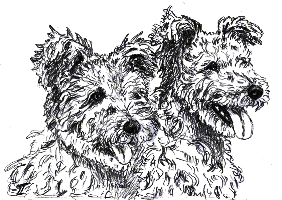PUMI — Hungarian shepherd terrier
Canis familiaris ovilis villosus terrarius Raitsitsi. (Anghi, 1935)
 Pumis were most probably born in the 17th-18th centuries,
from the interbreeding of pulis and French and German terrier-typed shepherd dogs.
According to some opinions, the conscious efforts of Hungarian shepherds also played an important part in it.
Pumis were most probably born in the 17th-18th centuries,
from the interbreeding of pulis and French and German terrier-typed shepherd dogs.
According to some opinions, the conscious efforts of Hungarian shepherds also played an important part in it.
It has been registered as a separate dog-breed since 1920.
In pumis, all the good qualities of pulis are unified with the terrier features of the breeds taking part in the interbreeding.
It has a medium-sized body (38—47 cm), a well-proportioned, attractive breed. It has a square trunk. It has a terrier-type head — the facial part is elongated, with clearly visible brown eyes, and ears erect and drooping at the end. It has a curling-up tail. All its body is covered with frizzly or curly fur in the form of ringlets, which has a uniform colour: it may be black, grey or white.
It can stand the hardships of weather well.
We cannot really see overweight, fat pumis.
It is extremely many-sided. Its natural environment is the flock or the herd and of course the proximitly of the shepherd, but it is also excellently apt for a watch-dog — it immediately reacts to the lowest unusual noise, baying eagerly. It also adopts quickly to flats, to luxurious environment. Its great advantage in this case, too, is the short fur, which can be kept clean and showy with one combing per week.
It is hot-tempered, searching, sniffing all the time, eagerly watching and completing orders individually, a colleague able to cope with several hundred sheep alone.
Autonomous, it is an «individual» always stating its opinios about everything. At the same time it is receptive, easy to be taught, «human-centered».
As it is usually said, pumis are «real clowns with enormous brains», real companions of man.
Finally let me quote the words of Viktor Katona, Gold-Wreath Master Breeder, the founder of «MOCSKOS» kennel registered among the best: «...we love pumis not (only) for their beauty, but for their intelligence...».
1994 © Länger György